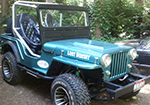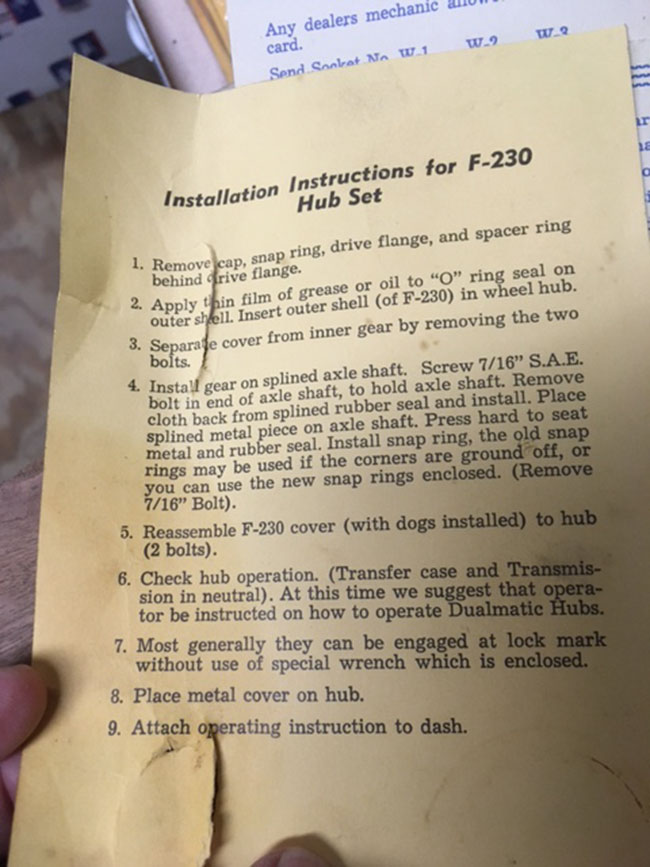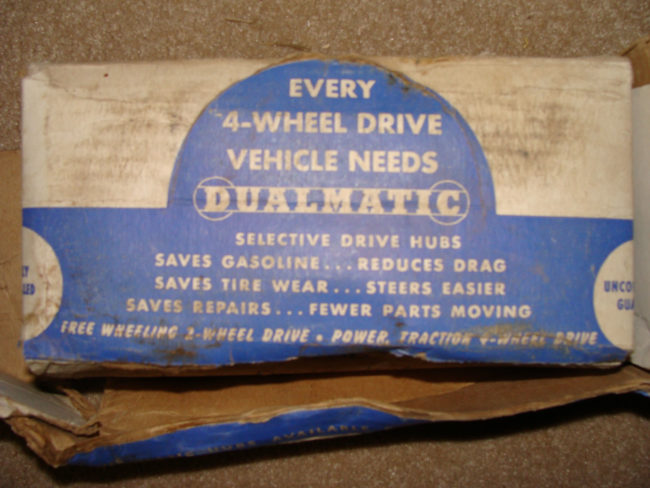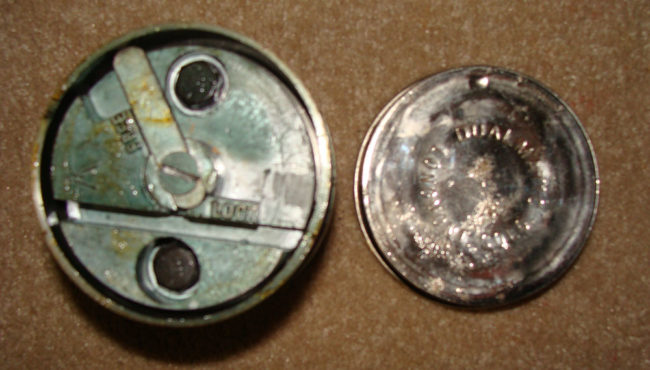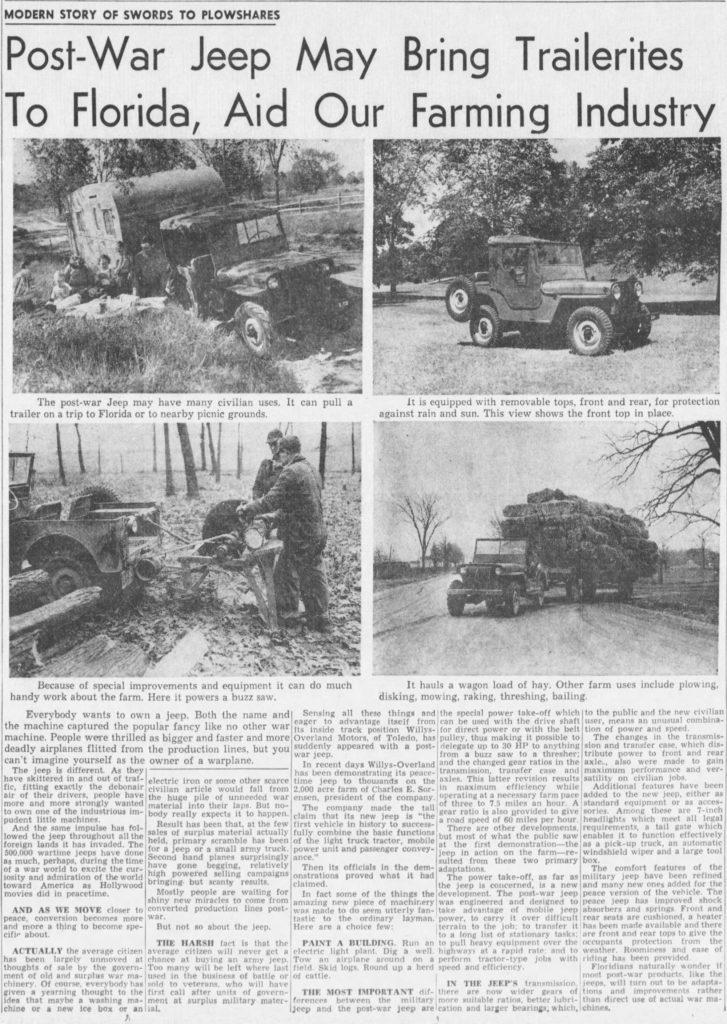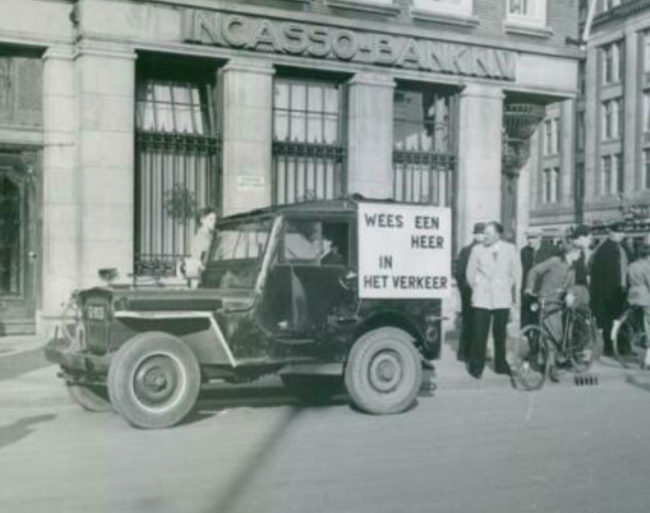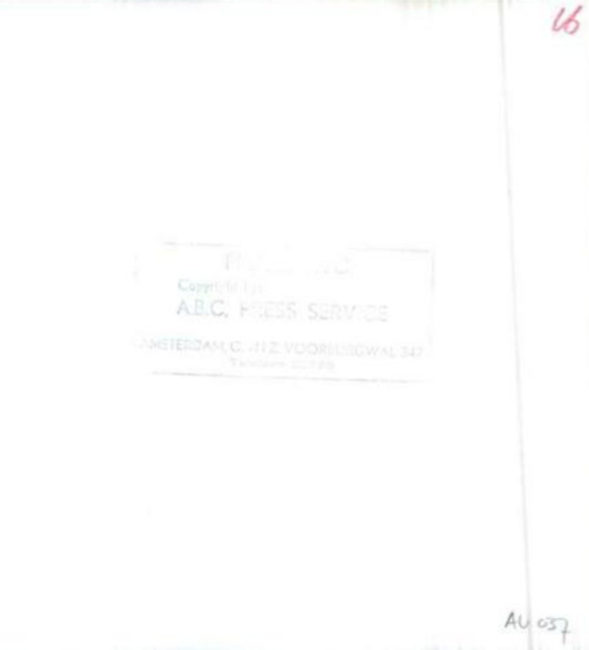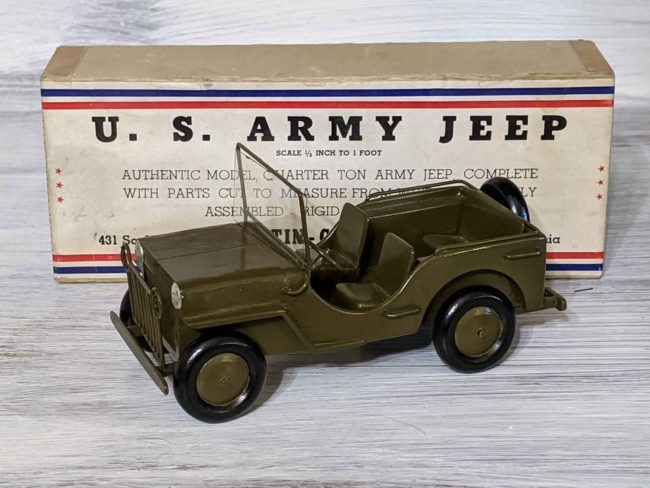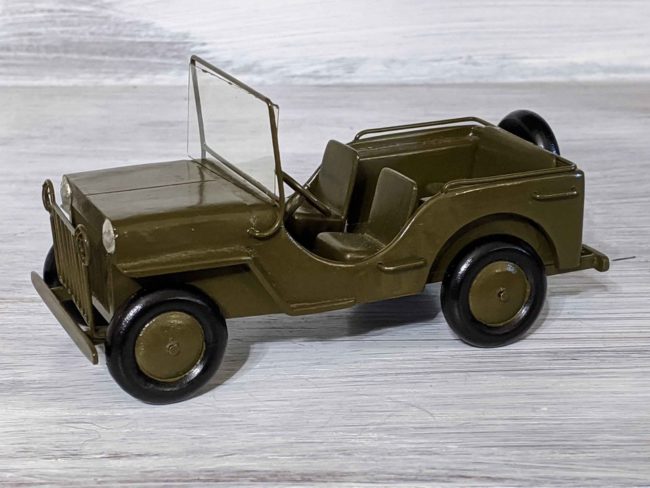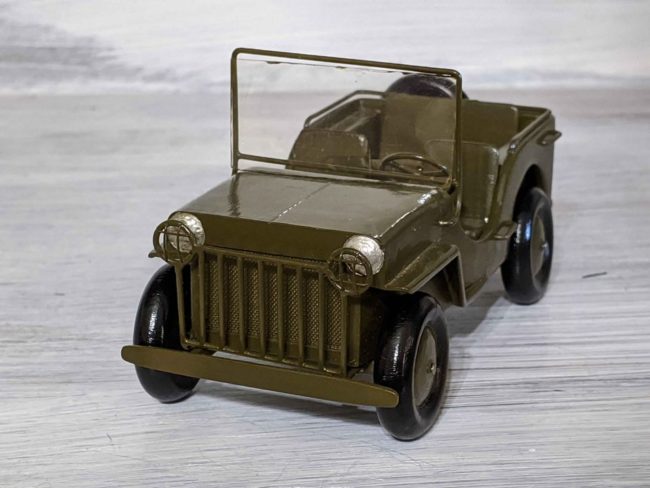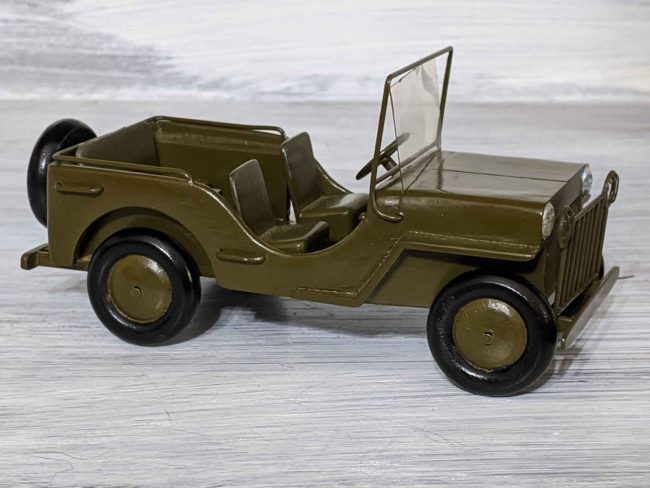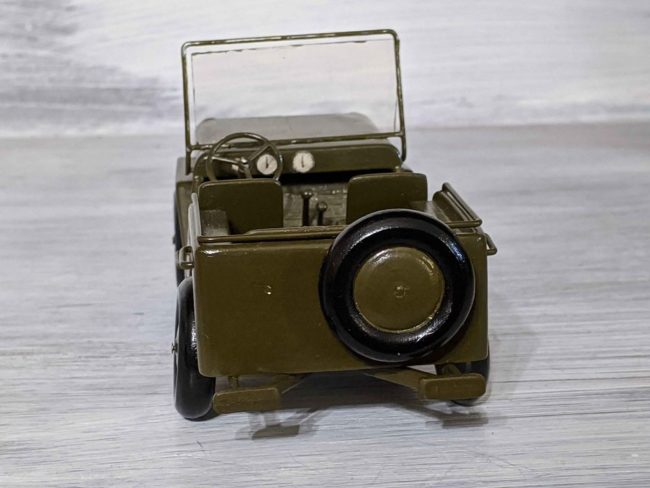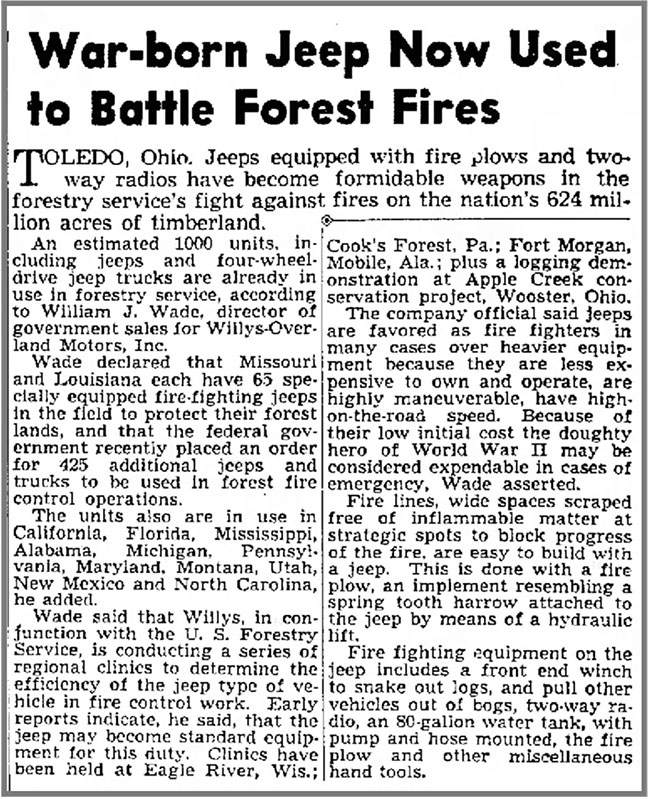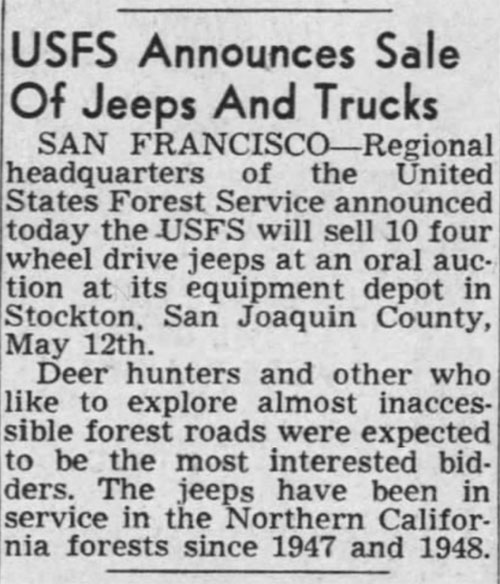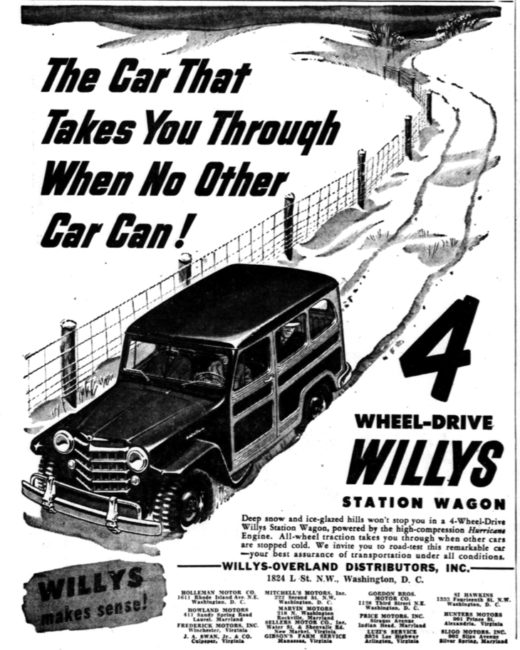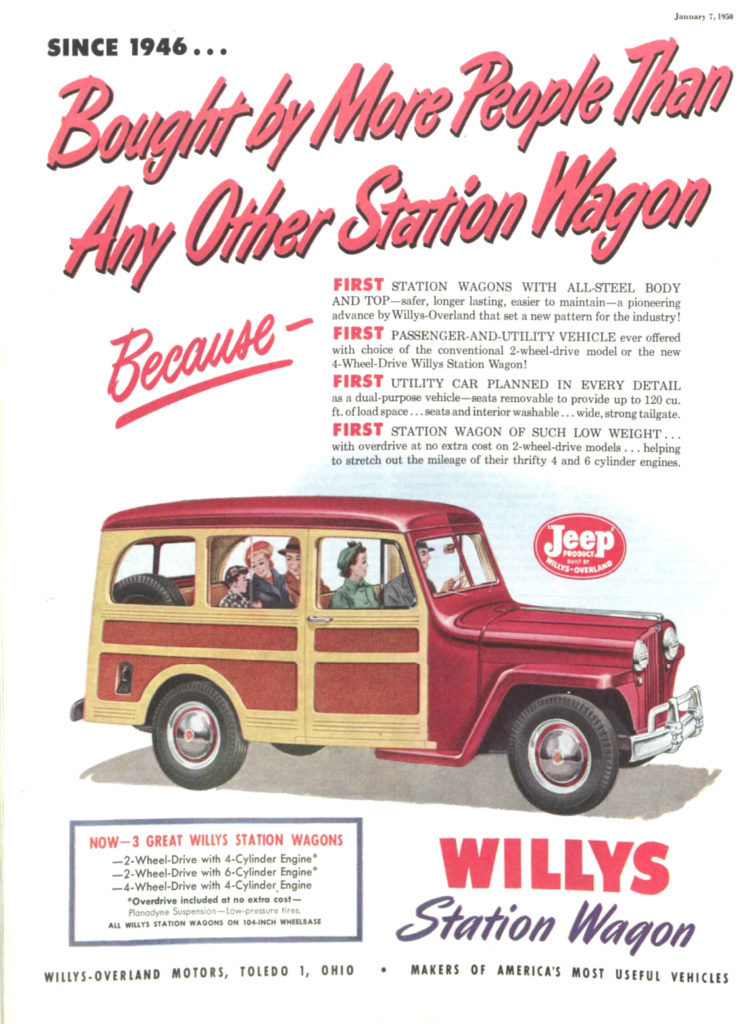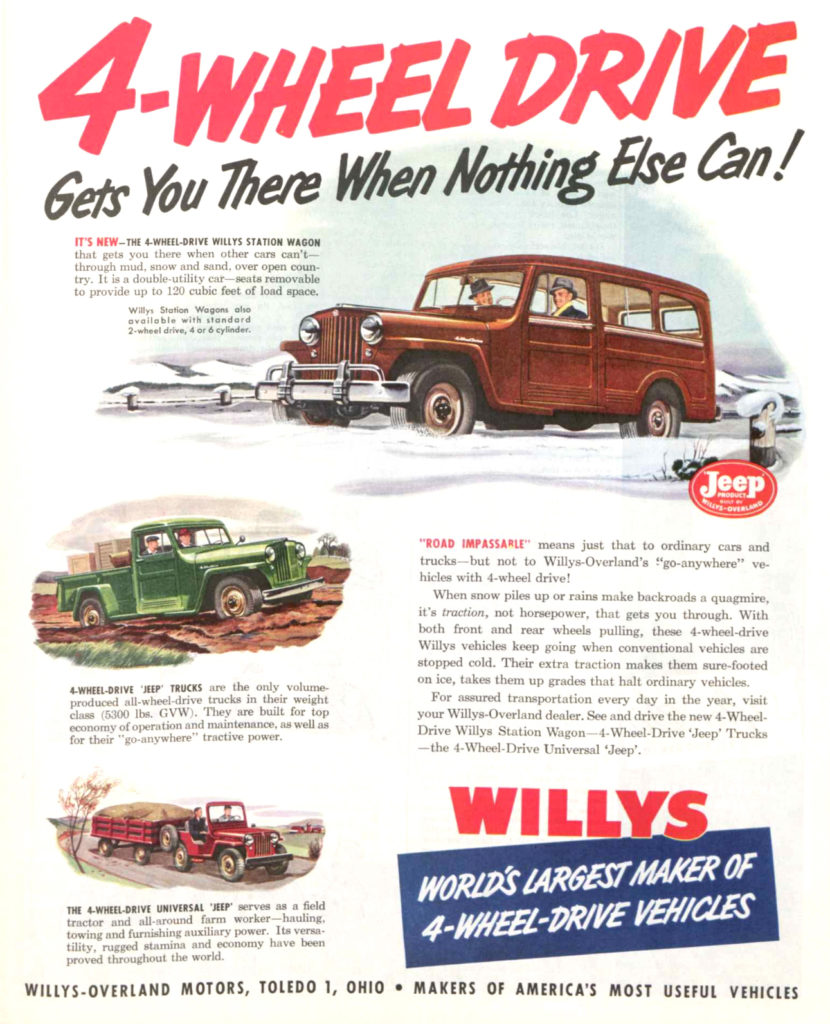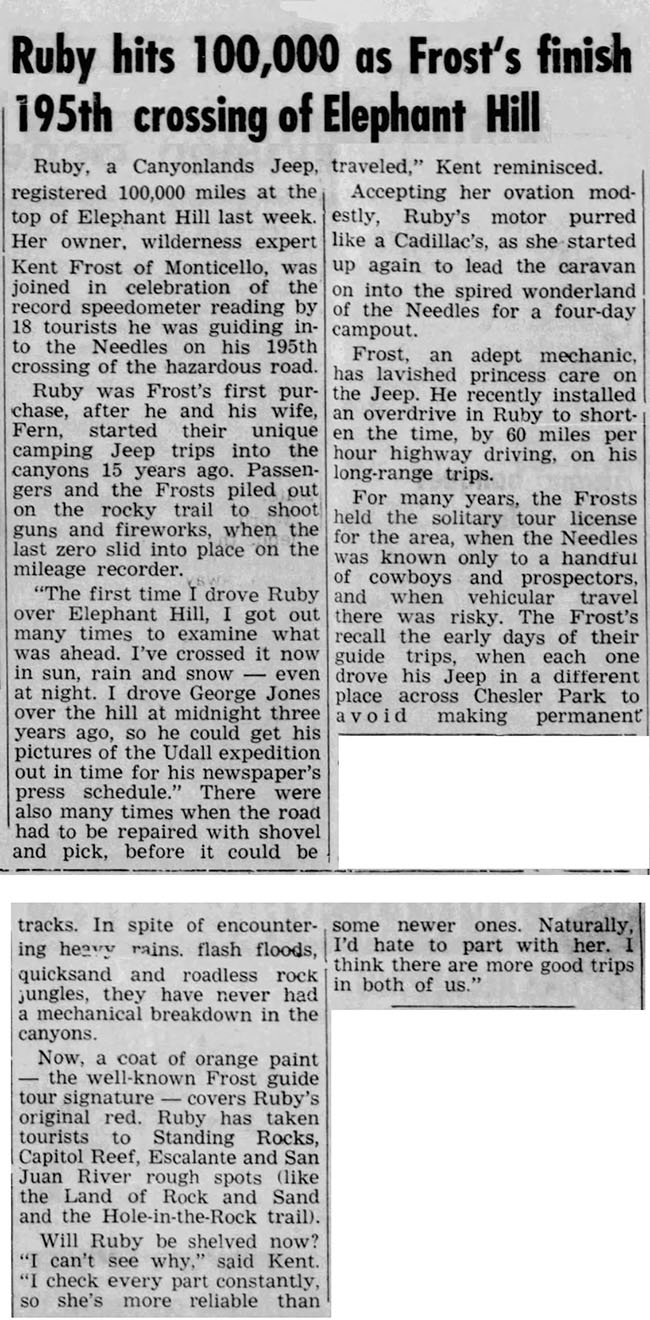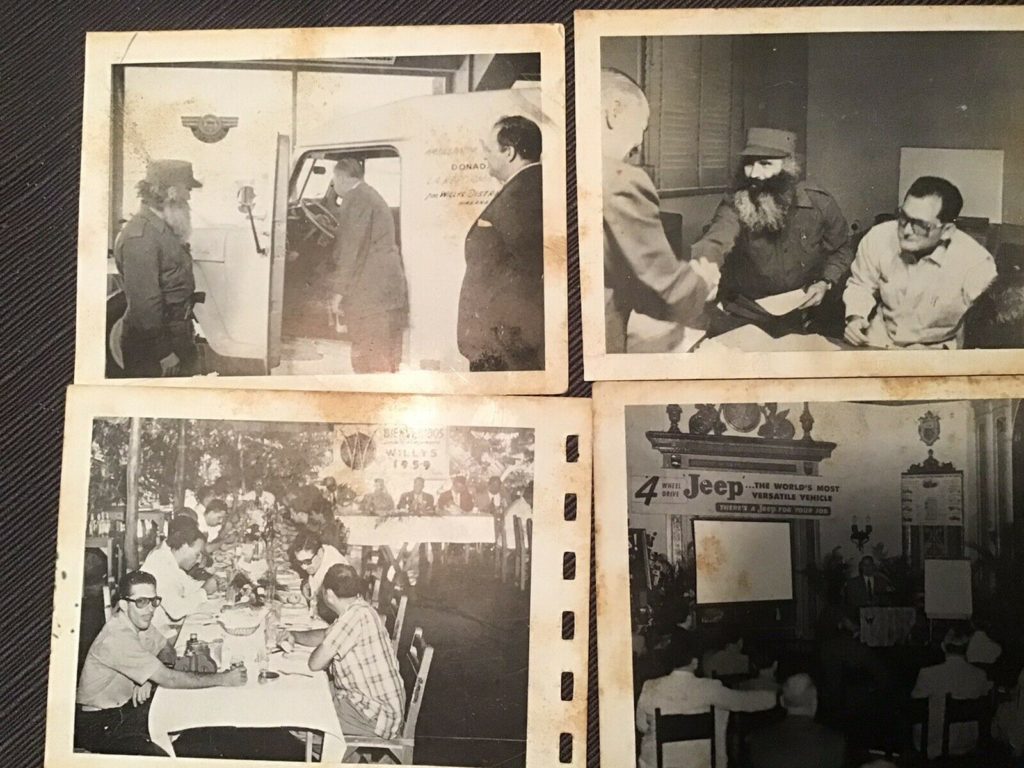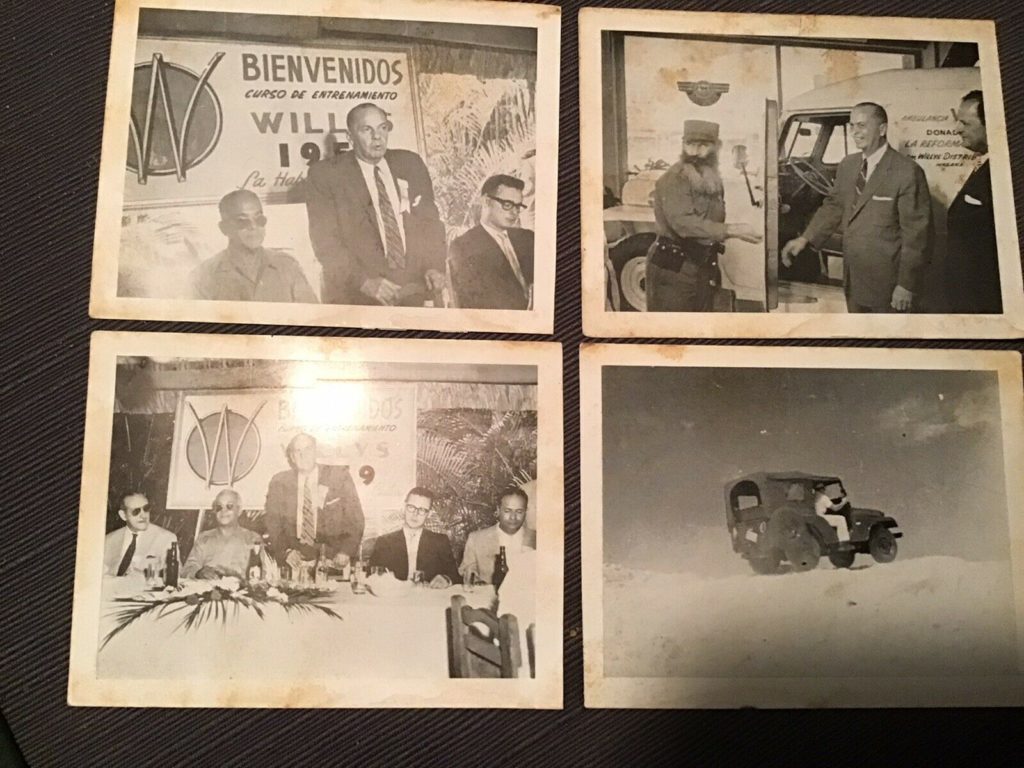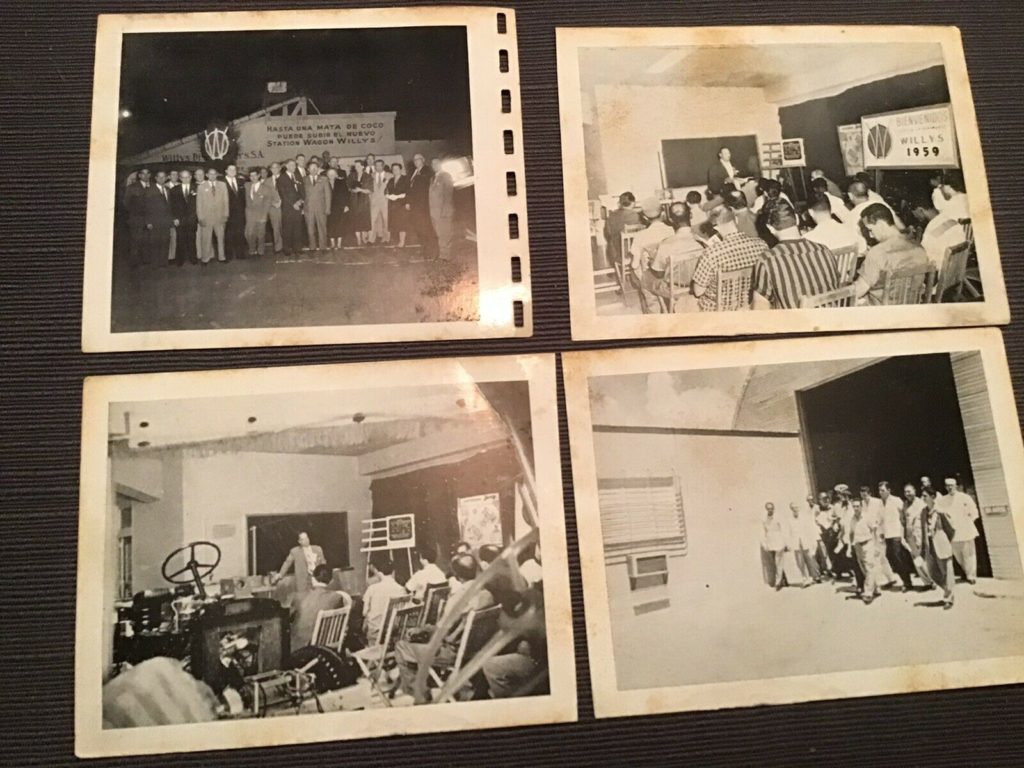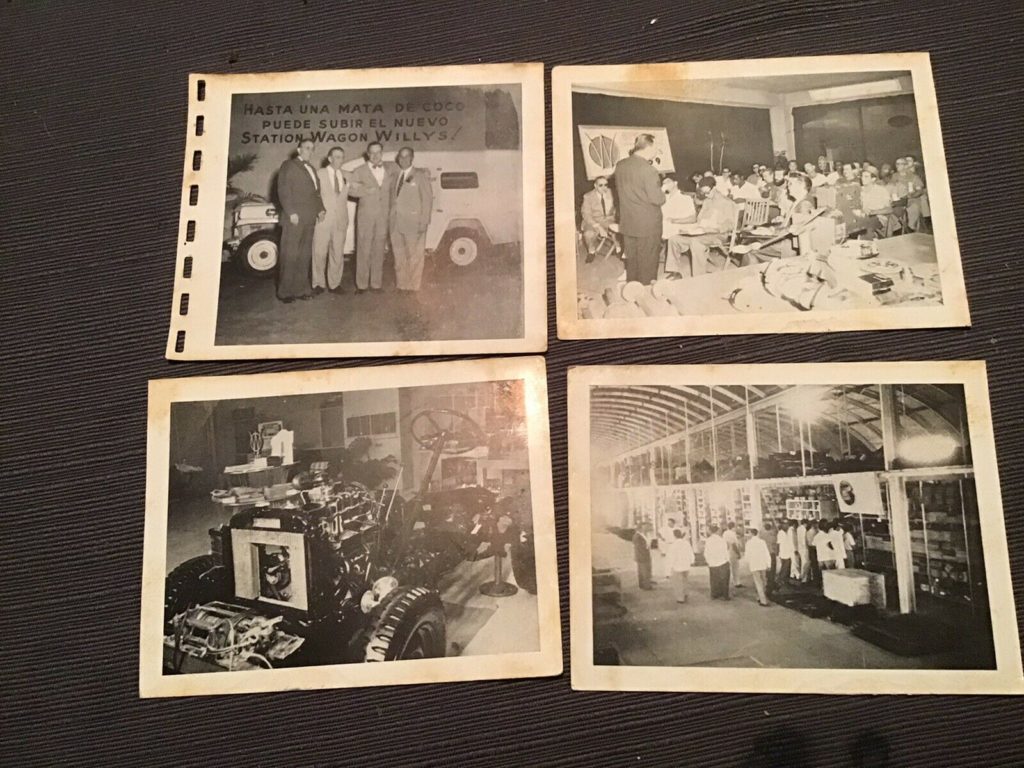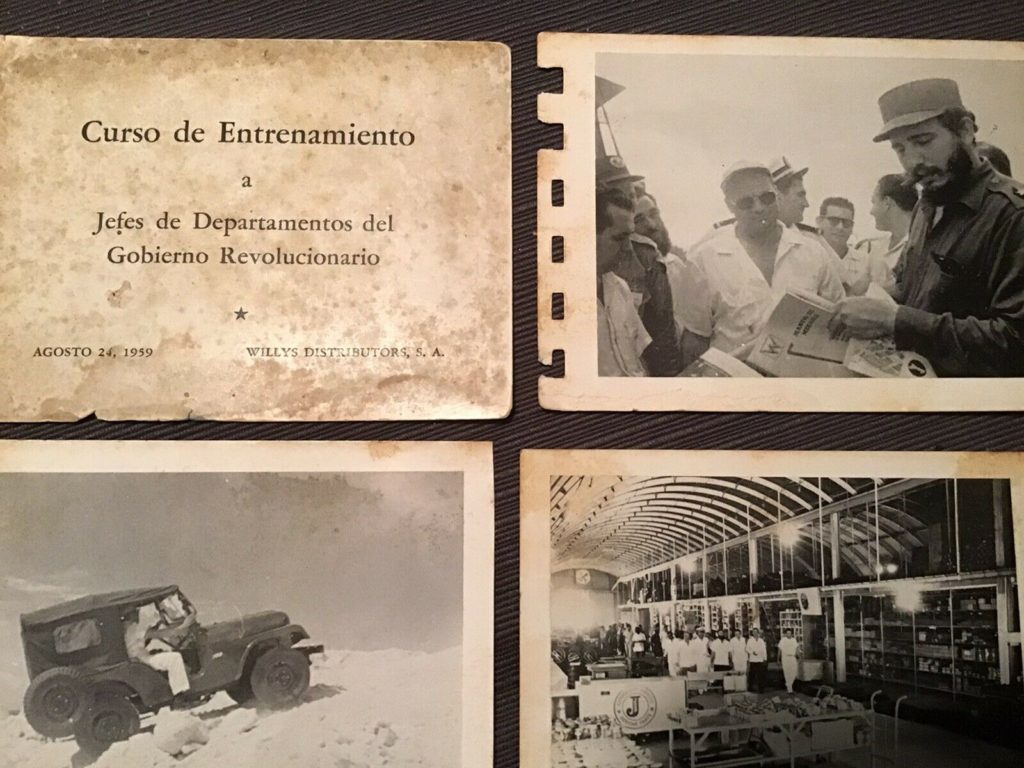Tim’s father-in-law purchased these Dualmatic hubs, but Tim’s unsure what vehicle they fit. Given the hub model number is F-230, we believe these were likely used on a Ford truck (possible the F-250, as that was the model of truck his father-in-law had). Anyone recognize them or know if they’d fit on a 1960s/70s Ford truck? The hubs are 19 spline.
Features Research Archives
July 1945 Article Introducing the Post-War Jeep to Florida
This July 22, 1945, article in the St. Petersburg Times employs both the pics and much of the text used published the press release covered by these posts.
1945 Article on Jeep Driver Lt. Paul Vermylen
This May 11, 1945, article in New York’s Brooklyn Eagle shares some stories from Lt. Paul Vermylen’s adventures as a jeep driver in Europe.
Paul Vermylen would go on to live a full life (obit here). He married right after the war, then ran his family’s pasta business, A. Zerega’s Sons (was family owned through May of 2020, now owned by Philadelphia Macaroni). He passed away in 2015 at the age of 96.
Year? Photo From the Netherlands on eBay
This undated photo from the Netherlands asks citizens in Dutch to “please be gentlemen in traffic”.
View all the information on eBay
“A jeep parked in the city with a sign on his car. ‘Be a gentleman in traffic’.
The Netherlands. Photo size: 6.8″ x 7.1″ inches”
1940s Prototype Model Goodyear, AZ $40
A sale is pending on this model jeep, but it looks to be a model based on the prototypes.
https://www.facebook.com/marketplace/item/373333757197973/
“Vintage 1940’s US Army Jeep Toy. This was a wood model assembled and painted very well. The windshield isn’t attached but kind of just sits on the frame. Awesome display piece.”
1944 Honeymoon Jeep
This “honeymoon” jeep was bedecked with whitewall (painted) tires and plenty of wedding finery. Inside the jeep was the price, WAC Cpl. Forence L. Bauer of Lyndhurst, Ohio, and Capt. Wilson W. Hopkins, Jr., of Durham, North Carolina. They spent their honeymoon in the Italian mountains during the late August of 1944.
Two Articles on Fire Fighting Jeeps for the USFS
This first article from January 22, 1950, in the Independent Press-Telegram (Long Beach, California) provides purchase numbers and eventual destinations for some Forest Service Jeeps.
This second article, from May 05, 1954, in the Sacramento Bee, notes the sale of 10 USFS jeeps that had been part of the Forest Service since 1947 and 1948.
Willys Makes Sense Campaign
UPDATE II: Here are two more Willys Make Sense ad that were featured in Sunday newspapers (seller indicates both were from 1951):
This one is currently on eBay for $20:
This one is currently on eBay for $20:
===========================
Originally posted May 29, 2019: Here’s another Willys Makes Sense ad from the February 13, 1951, issue of the Evening Star newspaper that differed from the others.
==================
Original Post: May 21, 2019:
In 1950, Willys-Overland launched a Willys Makes Sense advertising campaign. Unlike past campaigns, such as the 1948 City and City ads, which were about encouraging the sales of wagons and positioning the wagon as a luxury vehicle, the Willys Makes Sense appears to have been organized to re-imagine how the public should view the brand.
Before I get too deeply into this, I’d like to note that the way I’d prefer to write this article is to document specific reasons behind Willys-Overland’s decision to make such a big change. Unfortunately, I don’t have access to enough financial material as I’d like (especially annual reports). So, conjecture and theory will have to do for now.
BACKGROUND: After WWII, pent up demand meant lots of sales for automakers. That could explain, in part, why post-war sales were pretty good for Willys-Overland. For example, sales increased from almost 79,000 jeeps in 1946 to 159,000 jeeps in 1948. But, in 1949, sales plunged to almost half, coming in at 86,000. I don’t have details into why sales dropped so much, but likely parts or material shortages or labor disputes could have had an impact. Certainly, the recession of late 1948 – late 1949 didn’t help sales at all!
Future sales might not have looked too good for 1950 and beyond either. As of 1950 the US produced 76% of automobiles, but given the post-war rebuilding/resurging of industry world-wide, I expect automakers must have realized that international competition would return soon (by 1955 US market share would drop to 67%). This may have stimulated management to clean up their branding as soon as possible to protect against increasing competition (remember that Willys-Overland had expected to sell 25% of their autos internationally, based on the 1946 Fortunate Magazine article).
Another issue Willys-Overland was facing was that going into 1950 the company still didn’t have a registered trademark for the term JEEP (wouldn’t get it until June of 1950). Added to that, the company was not only producing 4WD 1/4 ton jeeps, trucks, and wagons, but also 2WD trucks, wagons, Jeepsters, and an upcoming automobile. Such a portfolio of non-4WD vehicles must have concerned management that it wasn’t just a “jeep” company; so the challenge of how the company should represent itself to dealers and consumers had to have become an issue.
Finally, in a similar vein, up until 1950, the company had been positioning itself as the ‘Jeep’ company, with ads that emphasized the Universal ‘Jeep’, the ‘Jeep’ Truck and the ‘Jeep’ Wagon. Perhaps with the introduction of the Jeepster (note that the company did not call it the ‘Jeep’ Jeepster nor was there any ‘Jeep’ branding on the introductory brochure), the branding issue must have really came to a head. Because of the entrenched nature of Willys-Overland’s efforts to become ‘Jeep’, management may have felt that a company-wide retooling of the company’s branding was in order.
Perhaps one, two, or all of these issues resulted in the 1950 rebrand of the company as a WILLYS manufacturer with a wide range of 2WD and 4WD vehicles for sale. (For a look back at 1952, see Derek’s post “When the CJ-3B Was New“).
NON-JEEP BRANDED ADS:
Willys-Overland began 1950 with an ad that felt similar to past ads, but excluded the ‘Jeep’ brand. For example, in January of 1950 Willys published this ad in the Saturday Evening Post. Note the reference to ‘Jeep’ has been replaced with a small ‘Jeep’ badge.
As did Colliers Magazine on January 21, 1950:
Kent Frost’s Jeep Reaches 100,000 Miles
UPDATE: This article from the San Juan Record dated October 22, 1965, provides more information on Kent Frost’s jeep Ruby and his treks over Elephant Hill.
 A better example of the photo appeared in the January 1966 Four Wheeler Magazine
A better example of the photo appeared in the January 1966 Four Wheeler Magazine
=========================
Original Post November 08, 2016: In January of 1966, Four Wheeler Magazine reported that Kent Frost’s CJ-5 Ruby had surpassed 100,00 miles. During that time Frost estimated he had crossed Elephant Hill 195 times through all kinds of weather, both day and night. Fittingly, the birthday celebration was held at the top of the hill. Here are a few pics of Ruby:
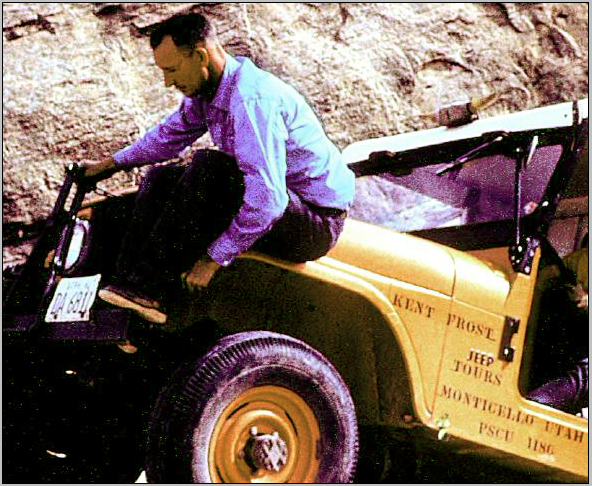 Continue reading
Continue reading
1959 Castro-Jeep Cuba Convention Photos on eBay
It appears this seller has separated these photos from the August 1959 Jeep convention with Castro in Cuba, listing them in multiple auctions.
“Fidel Castro Willys Jeep 1959 Convention Photos. These are from an original 1959 willys Jeep South American convention folio the year of Castros takeover. A variety of shots,including Castro Holding a Willys manual. Printed 2 sides. App. 31/2” x 5” each.Condition is “Used”. Shipped with USPS First Class”
